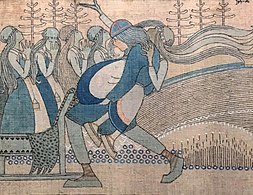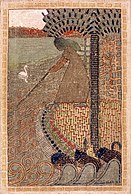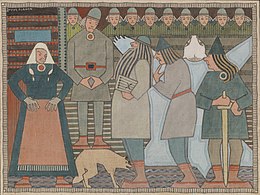| This article needs additional citations for verification. Please help improve this article by adding citations to reliable sources. Unsourced material may be challenged and removed. Find sources: "Lemminkäinen" – news · newspapers · books · scholar · JSTOR (December 2009) (Learn how and when to remove this message) |

Lemminkäinen (Finnish pronunciation: [ˈlemːiŋˌkæi̯nen]) or Lemminki (pronounced [ˈlemːiŋki]) is a prominent figure in Finnish mythology. He is one of the heroes of the Kalevala, where his character is a composite of several separate heroes of oral poetry. He is usually depicted as young and good-looking, with wavy red hair.
Description
The original, mythological Lemminkäinen is a shamanistic figure. In the Kalevala, he has been blended together with epic war-heroes Kaukomieli/Kaukamoinen and Ahti Saarelainen.
In one myth, he drowns in the river of Tuonela (the underworld) in trying to capture or kill the black swan that lives there as part of an attempt, as Ilmarinen once made, to win a daughter of Louhi as his wife. In a tale somewhat reminiscent of Isis' search for Osiris, Lemminkäinen's mother searches heaven and earth to find her son. Finally, she learns of his fate and asks Ilmarinen to fashion her a rake of copper with which to dredge her son's body from the river of Tuonela. Thus equipped, she descends into the underworld in search of her son. On the banks of the river of the underworld, she rakes up first Lemminkäinen's tunic and shoes, and then, his maimed and broken body. Unrelenting, she continues her work until every piece of Lemminkäinen's body is recovered. Sewing the parts together and offering prayers to the gods, the mother tries to restore Lemminkäinen to life, but while she succeeds in remaking his body, his life is still absent. Then, she entreats a bee to ascend to the halls of the over-god Ukko and fetch from there a drop of honey as ointment that would bring Lemminkäinen back to life. Only with such a potent remedy is the hero finally restored.
One of the challenges Lemminkäinen faced was a character named Surma. Surma was a terrible beast which embodied sudden, violent death and guarded the gates of the Tuonela to prevent escape. Surma is often described as being a large dog with a snake-tail that can turn people into stone (with a stare). An often-used Finnish metaphor is surman suuhun "into Surma's mouth", as if the victim was mauled to death by Surma.
Lemminkäinen in arts
Lemminkäinen is the subject of the four-part "Lemminkäinen Suite" by Jean Sibelius, and of an overture by Väinö Haapalainen [fi], both of them Finnish composers.
Parts of the story of Lemminkäinen and Kullervo are used by Elizabeth Goudge (1900-1984) in her 1938 play Suomi, one of her Three Plays: Suomi; The Brontës of Haworth; Fanny Burney (Gerald Duckworth, 1939). Goudge's modern play, set in 1899, 1917 and 1918, has modern characters, fighting for Finnish independence from Tsarist Russia. These include "Suomi", the mother, nicknamed after the Finnish word for "Finland", and her sons, Olof and Kyosti. Olof, a version of Lemminkäinen, marries a Russian woman, and is killed by his enemies, but seemingly resurrected in his son, Sigurd. Kyosti, a version of Kullervo, kills Sigurd, and then commits suicide. Goudge's play includes quotes from the Kalevala and Sibelius's Finlandia.
The 2007 album (Silent Waters) of Finnish metal band Amorphis is about the story of Lemminkäinen.
The 2008 song (River of Tuoni) by Finnish metal band Amberian Dawn is about Lemminkäinen's mother's search for him in the river of Tuoni.
Lemminkäinen appears as Lemminkal Heikkinen the Warrior-Mage in Mercedes Lackey's 500 Kingdoms Series' homage to Sámi, among other Scandinavian and northern European myths and legends, The Snow Queen (2008).
The 2018 song The Bee by Finnish metal band Amorphis also references the story of Lemminkäinen and of the bee entrusted by his mother to retrieve honey from the halls of the over-god Ukko.
Lemminkäinen is the protagonist of the 1959 film, The Day the Earth Froze.
The Dungeons & Dragons character Mordenkainen is partially named after him.
Lemminkäinen in Films
- (in English) "Back to Lemminkäinen" – (Documentary Series, 2020)
Gallery
-
 Lemminkäinen, Carl Eneas Sjöstrand, 1872
Lemminkäinen, Carl Eneas Sjöstrand, 1872
-
 Abduction of Kyllikki, Johan Kortman, 1890
Abduction of Kyllikki, Johan Kortman, 1890
-
 Abduction of Kyllikki, Joseph Alanen [fi], 1916–1917
Abduction of Kyllikki, Joseph Alanen [fi], 1916–1917
-
 The Ski Hunt of the Moose of Hiisi, Väinö Hämäläinen [fi], 1902
The Ski Hunt of the Moose of Hiisi, Väinö Hämäläinen [fi], 1902
-
 The Chase of the Moose of Hiisi, Akseli Gallen-Kallela, 1894
The Chase of the Moose of Hiisi, Akseli Gallen-Kallela, 1894
-
 The Death of Lemminkäinen, Robert Wilhelm Ekman, 1860
The Death of Lemminkäinen, Robert Wilhelm Ekman, 1860
-
 Lemminkäinen's Mother at the River of Tuonela, Joseph Alanen, 1908–1911
Lemminkäinen's Mother at the River of Tuonela, Joseph Alanen, 1908–1911
-
 Lemminkäinen's Mother at Tuonela, Robert Wilhelm Ekman, 1862
Lemminkäinen's Mother at Tuonela, Robert Wilhelm Ekman, 1862
-
 Lemminkäinen at the River of Fire, Akseli Gallen-Kallela, 1920
Lemminkäinen at the River of Fire, Akseli Gallen-Kallela, 1920
-
 Lemminkäinen and the Fiery Eagle, Robert Wilhelm Ekman, 1867
Lemminkäinen and the Fiery Eagle, Robert Wilhelm Ekman, 1867
-
 Lemminkäinen at the Fiery Lake, Robert Wilhelm Ekman, c. 1867, depicting the call for help from Ukko
Lemminkäinen at the Fiery Lake, Robert Wilhelm Ekman, c. 1867, depicting the call for help from Ukko
-
 Lemminkäinen and the Great Snake, Joseph Alanen, 1919–1920
Lemminkäinen and the Great Snake, Joseph Alanen, 1919–1920
-
 The Departure of Lemminkäinen from Saari, Pekka Halonen, 1899
The Departure of Lemminkäinen from Saari, Pekka Halonen, 1899
-
 Arrival of Väinämöinen, Ilmarinen and Lemminkäinen at Pohjola, tempera by Joseph Alanen
Arrival of Väinämöinen, Ilmarinen and Lemminkäinen at Pohjola, tempera by Joseph Alanen
-
 The Retrieval of Sampo from the Stone Hill of Pohjola, where Lemminkäinen ploughs the roots with a Pohjola bull, mosaic by Veikko Aaltona [fi], 1940
The Retrieval of Sampo from the Stone Hill of Pohjola, where Lemminkäinen ploughs the roots with a Pohjola bull, mosaic by Veikko Aaltona [fi], 1940
See also
References
- Harvilahti, Lauri (21 March 2005). "Lemminkäinen". Kansallisbiografia. Retrieved 23 August 2020.
- "Lemminkäinen". Sammon Salat. Opetushallitus 2017. Retrieved 23 August 2020.
- Lönnrot, Elias (ed.). Kalevala (1849), 13. runo.
- Pulakka, Raisa; Tuikka, Raili. Eläimet saattavat kuoleman maahan. Yle Kulttuuri 15.01.2016.
Books
- Pentikäinen, Juha (1987). "Kalevala Mythology, Revised Edition". Google Books (originally Indiana University Press). Retrieved 27 February 2017.
| Gods | |
|---|---|
| Heroes | |
| Villains | |
| Others | |
| Places | |
| Things | |
| Works inspired by the Kalevala | |
| Other related |
|
This article related to Finnish paganism or mythology is a stub. You can help Misplaced Pages by expanding it. |